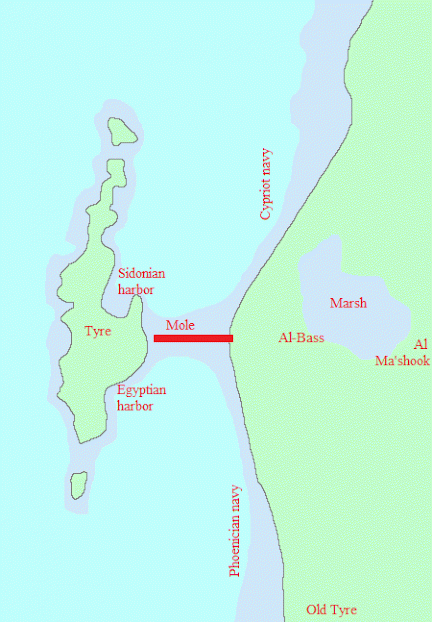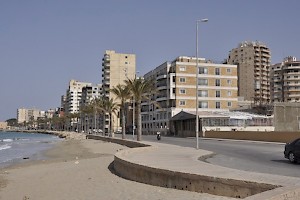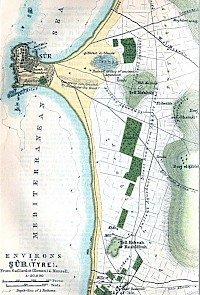Tyre, Alexander's Mole
Tyre (Phoenician צר, ṣūr, "rock"; Greek Τύρος; Latin Tyrus): port in Phoenicia and one of the main cities in the eastern Mediterranean.
Preliminaries

In 334, the Macedonian king Alexander the Great attacked the Persian Empire, which immediately launched a naval expedition against the countries along the Aegean Sea, threatening to cut off Alexander's lines of communication. However, the Macedonian army proceeded to Syria and defeated the Persian main force at Issus (November 333). Having secured control of the land, Alexander and his army proceeded to Phoenicia. Once the Phoenician coastal cities had been occupied, Persia would no longer be able to attack Greece and Macedonia.
Most Phoenician cities immediately surrendered, except Tyre, which was built on an island, some six hundred or seven hundred meters out of the coast. It would be very hard to capture for a Macedonian army that could not use a navy. Undeterred, Alexander commanded the building of a mole.
The siege

Not that this was any easier. The inhabitants of Tyre had excellent ships and made construction work extremely difficult. On one occasion, the defenders loaded a ship full of combustibles, towed it into the open sea, and made it crash into the mole, which was consequently destroyed. However, the Macedonians broadened their structure and continued to work.
At some point, the dam was sufficiently long to bring Tyre within the reach of the catapults. Every day, the Macedonians came closer to the Phoenician city, allowing the catapults to become increasingly dangerous.

Meanwhile, the Persian navy had disintegrated and many Phoenician ships returned home, where their sailors sided with Macedonia. Tyre's fate was now sealed.
Having control of the sea, Alexander could finally attack. The first attempt failed, but several days later, he tried it again, approaching the island city from three sides: the fleet of the Phoenicians destroyed the Tyrian fleet in the "Egyptian port"; Macedonian ships attacked the walls with siege engines; and marines from Cyprus landed in the "Sidonian port" and forced their way into the city. This was the end of Tyre.
Later centuries
For centuries, the mole was an obstacle to the sea currents. Sediments were deposited and the city that had been connected with the main land by a dam became a wide peninsula. In the mid-nineteenth century, the course of Alexander's mole was still visible; nowadays, there are too many modern buildings to recognize anything. If the nineteenth-century map is accurate, the dam was a bit south of the main road that connects the Al-Bass cemetery to Hiram's Tower and the island city itself.